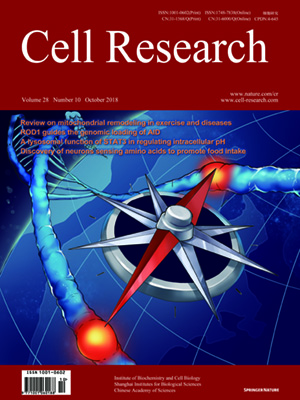
Advanced Search
Submit Manuscript
Advanced Search
Submit Manuscript
Volume 28, No 10, Oct 2018
ISSN: 1001-0602
EISSN: 1748-7838 2018
impact factor 17.848*
(Clarivate Analytics, 2019)
Volume 28 Issue 10, October 2018: 981-995 |
Juan Chen 1,2, Zhaokui Cai 1,2, Meizhu Bai 3,4, Xiaohua Yu 1,2, Chao Zhang 5, Changchang Cao 1,2, Xihao Hu 1,2, Lei Wang 1,6, Ruibao Su 1,2,Di Wang 1,2, Lei Wang 1,2, Yingpeng Yao 7, Rong Ye 1,2, Baidong Hou 5, Yang Yu1, Shuyang Yu7, Jinsong Li3,4 and Yuanchao Xue1,2
1Key Laboratory of RNA Biology, CAS Center for Excellence in Biomacromolecules, Institute of Biophysics, Chinese Academy of Sciences, 100101 Beijing, China; 2University of Chinese Academy of Sciences, 100049 Beijing, China; 3State Key Laboratory of Molecular Biology, Shanghai Key Laboratory of Molecular Andrology, CAS Center for Excellence in Molecular Cell Science, Shanghai Institute of Biochemistry and Cell Biology, Chinese Academy of Sciences; University of Chinese Academy of Sciences, 320 Yueyang Road, 200031 Shanghai, China; 4School of Life Science and Technology, ShanghaiTech University, 100 Haike Road, 201210 Shanghai, China; 5Key Laboratory of Infection and Immunity, Institute of Biophysics, Chinese Academy of Sciences, 100101 Beijing, China; 6College of Life Sciences, Institute for Conservation and Utilization of Agro-bioresources in Dabie Mountains, Xinyang Normal University, 464000 Xinyang, China and 7State Key Laboratory of Agrobiotechnology, College of Biological Sciences, China Agricultural University, Beijing, People’s Republic of China Correspondence: Correspondence: Yuanchao Xue (ycxue@ibp.ac.cn)These authors contributed equally: Juan Chen, Zhaokui Cai, Meizhu Bai, Xiaohua Yu, Chao Zhang
https://doi.org/10.1038/s41422-018-0076-9